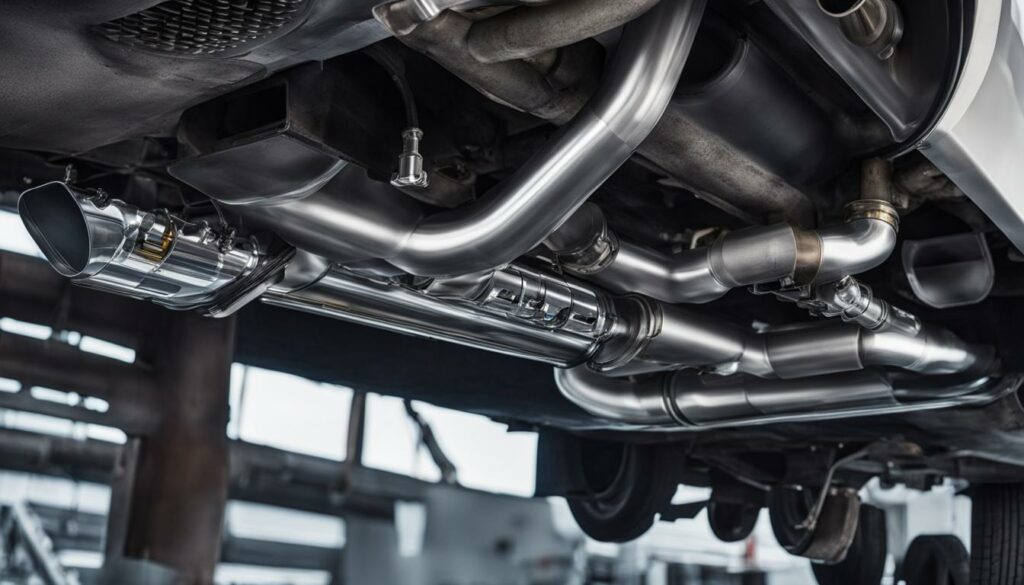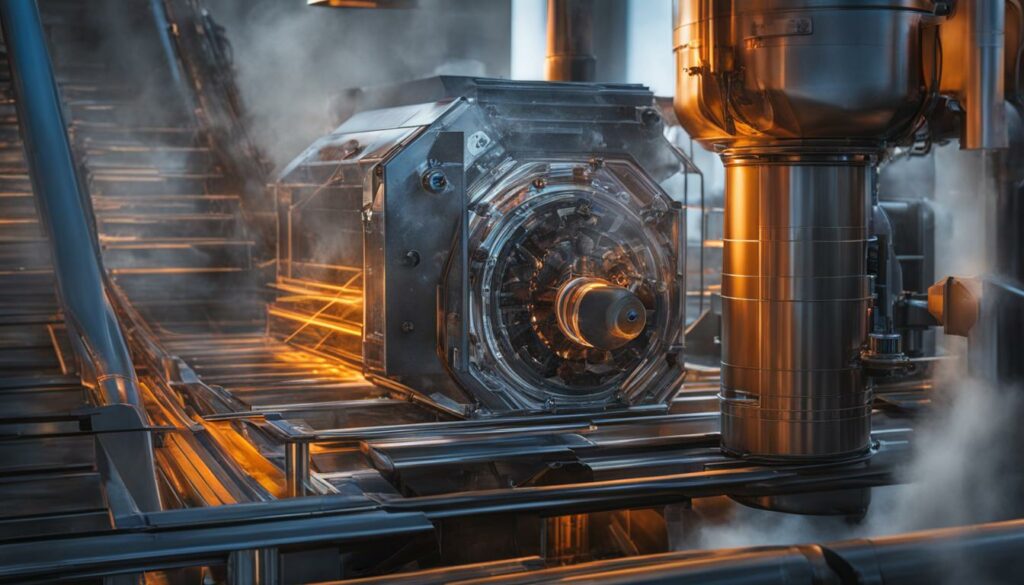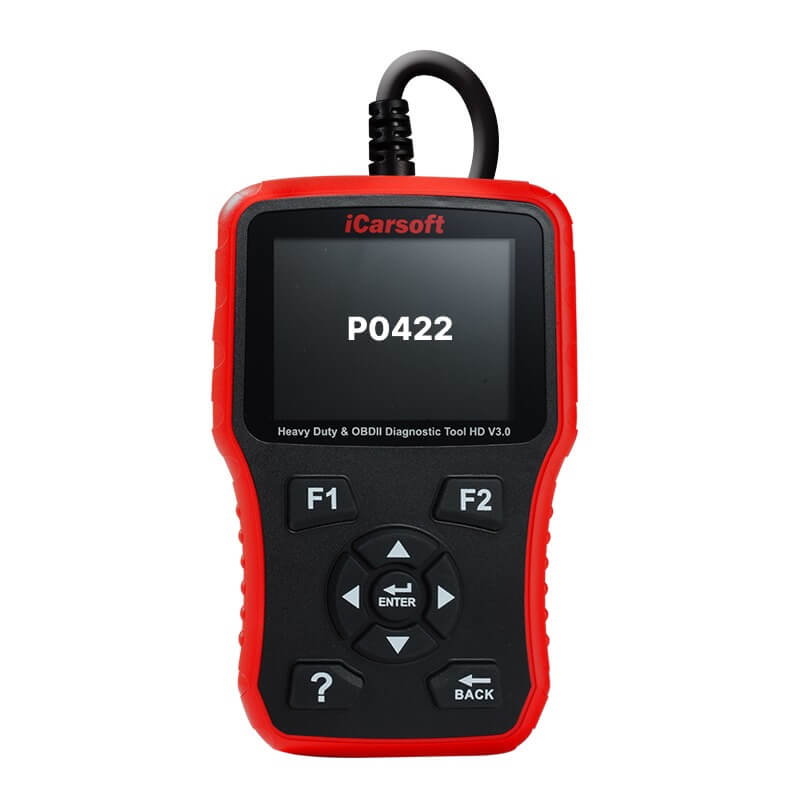P0422 – Main Catalyst Efficiency Below Threshold
POSTED IN pcodes
If you’ve recently noticed your vehicle’s check engine light illuminated, it could be due to a specific engine code – P0422. This code indicates that the main catalyst efficiency in your vehicle’s catalytic converter is below the minimum threshold required for optimal performance and emissions. It is important to address this issue promptly to ensure your vehicle meets the necessary emission standards and to prevent any potential damage to the engine or catalytic system.
In this article, we will explore the technical description, meaning, severity, symptoms, common causes, troubleshooting steps, and potential repairs associated with the P0422 code. By understanding the details of this engine code, you will be better equipped to diagnose and address any issues related to your vehicle’s catalyst efficiency.
Key Takeaways:
- P0422 is an engine code that indicates the main catalyst efficiency in the catalytic converter is below the minimum threshold.
- This code can be triggered by several factors, including faulty catalytic converters, malfunctioning oxygen sensors, exhaust leaks, or internal engine damage.
- Symptoms may include an illuminated check engine light, while other performance issues may not be noticeable.
- Diagnosing and repairing the P0422 code can be complex and may require professional assistance.
- It is important to address this issue promptly to maintain proper vehicle emissions and to prevent potential damage to the engine or catalytic system.
What Does the P0422 Code Mean?
The P0422 code is an engine diagnostic code that indicates an issue with the emissions efficiency of the catalytic converters in Bank 1. Specifically, it means that the emissions efficiency of the catalytic converters in Bank 1 is below the minimum allowable limit.
The emissions efficiency of a catalytic converter is crucial for reducing harmful pollutants in the exhaust gases before they are released into the atmosphere. The catalytic converter’s function is to oxygenate the exhaust gases and promote the conversion of harmful compounds such as carbon monoxide, nitrogen oxides, and hydrocarbons into less harmful substances.
The P0422 code is monitored by the catalyst monitor oxygen sensor, which is typically located near the outlet of the catalytic converter in Bank 1. This sensor measures the efficiency of the catalytic converter by monitoring the levels of oxygen before and after the catalytic conversion process.
Buy tested tuning file for Adblue / EGR / DPF / Adblue off now!
The engine control module (ECM) tracks the switching frequency of the heated oxygen sensors to determine if the catalytic converter is functioning properly. The P0422 code is logged when the frequency ratio of both heated oxygen sensors reaches the specified threshold, indicating that the catalytic converter is not operating efficiently.

Common Causes of the P0422 Code
The P0422 code can be triggered by various common causes that affect the emissions efficiency of the catalytic converter. Understanding these causes is essential for accurate diagnosis and effective repairs.
- Defective Catalytic Converter: A faulty or worn-out catalytic converter can result in reduced emissions efficiency and trigger the P0422 code. Over time, the catalyst material inside the converter may deteriorate, leading to improper conversion of harmful gases.
- Malfunctioning Oxygen Sensor: The oxygen sensor plays a critical role in measuring the oxygen levels in the exhaust gases. If the sensor is faulty or sending incorrect readings to the engine control module (ECM), it may cause the P0422 code to be logged.
- Exhaust Leak: Any leaks in the exhaust system, such as cracked or damaged pipes, can disrupt the proper functioning of the catalytic converter. Unmetered air entering the system can affect the exhaust gases’ oxygen levels and trigger the P0422 code.
- Engine Damage: Engine misfires or internal damage, such as a leaking head gasket, can impact the combustion process and lead to increased oil consumption. This, in turn, can decrease the efficiency of the catalytic converter and trigger the P0422 code.
- High Oil Consumption: Excessive oil consumption can result from worn-out engine components or improper engine maintenance. When the engine burns excessive oil, it can generate emissions that overload the catalytic converter and trigger the P0422 code.
Proper diagnosis is crucial to determine the specific cause of the P0422 code. A comprehensive inspection of the catalytic converter, oxygen sensor, exhaust system, and engine components may be necessary to identify the underlying issue.
Common Causes of the P0422 Code
| Cause | Description |
|---|---|
| Defective Catalytic Converter | A faulty or worn-out catalytic converter can result in reduced emissions efficiency. |
| Malfunctioning Oxygen Sensor | A faulty oxygen sensor can send incorrect readings to the engine control module. |
| Exhaust Leak | Leaks in the exhaust system, such as cracked pipes, can disrupt the proper functioning of the catalytic converter. |
| Engine Damage | Engine misfires or internal damage can decrease the efficiency of the catalytic converter. |
| High Oil Consumption | Excessive oil consumption can overload the catalytic converter and trigger the P0422 code. |
Symptoms and Diagnosis of the P0422 Code
When your vehicle’s check engine light is illuminated, it could be an indication of a P0422 code. This code is associated with the catalytic converter system and indicates that the catalytic converters in Bank 1 are not operating at the minimum allowable efficiency threshold. While some symptoms may not be noticeable, the most common symptom is the illuminated check engine light.
To diagnose the P0422 code, a diagnostic trouble code (DTC) scanner is used to retrieve the code and check for any accompanying trouble codes. The DTC scanner provides valuable information about the specific issue with your vehicle. Additionally, the mechanic will also check the monitor readiness to determine which systems are ready and which are not.
Further diagnostic steps may involve inspecting the wiring and connectors related to the catalytic converter system. It is important to check for any damaged or loose connections that may affect the performance of the system. The mechanic will also inspect the exhaust system for any leaks or damage that could contribute to the P0422 code.
| Diagnosis Steps for P0422 Code |
|---|
| 1. Retrieve the P0422 code using a diagnostic trouble code (DTC) scanner. |
| 2. Check for any accompanying trouble codes. |
| 3. Inspect the monitor readiness to determine system readiness. |
| 4. Examine the wiring and connectors related to the catalytic converter system. |
| 5. Inspect the exhaust system for leaks or damage. |
| 6. Check the condition of the oxygen sensors. |
As part of the diagnostic process, the mechanic will also assess the condition of the oxygen sensors. These sensors play a crucial role in monitoring the air-fuel ratio and emissions levels. If the oxygen sensors are faulty, they can contribute to the P0422 code. However, it is important to note that the oxygen sensors should be thoroughly inspected before considering replacement.
By following these diagnostic steps, a qualified mechanic can pinpoint the specific cause of the P0422 code and recommend appropriate repairs. It is important to address the issue promptly to ensure optimal performance and reduced vehicle emissions.

Repairs for the P0422 Code
When it comes to addressing the P0422 code, the specific repairs needed will depend on the underlying cause. In most cases, the potential solutions include replacing a faulty catalytic converter, oxygen sensor, or fixing any exhaust leaks. To ensure precise diagnosis and effective repairs, it is highly recommended that you consult with a professional mechanic or take your vehicle to a reputable repair shop.
If your catalytic converter is still under warranty, it’s important to check the terms and conditions provided by your auto manufacturer. Many manufacturers offer a generous 100,000-mile warranty for catalytic converters, which could save you substantial repair costs. In the event that replacement parts are required, it’s advisable to order from a trusted source like Magnaflow, known for their quality and reliability.
By entrusting your P0422 code repairs to trained professionals and utilizing reputable brands like Magnaflow, you can have peace of mind knowing that your vehicle is in good hands. Remember, accurate diagnostics and efficient repairs are key to resolving the P0422 code and ensuring optimal performance and emissions efficiency.
FAQ
What does the P0422 code mean?
The P0422 code indicates that the catalytic converters in Bank 1 are operating below the minimum allowable threshold for emissions efficiency. It is often triggered by issues such as a faulty catalytic converter, malfunctioning oxygen sensor, exhaust leak, or internal engine damage.
What are the common causes of the P0422 code?
The P0422 code can be caused by a defective catalytic converter, malfunctioning oxygen sensor, exhaust leak, damaged catalytic converter due to engine misfires, a leaking head gasket, or internal engine damage leading to high oil consumption.
What are the symptoms and diagnosis of the P0422 code?
The most common symptom of the P0422 code is an illuminated check engine light. Diagnosing the P0422 code involves using a diagnostic trouble code scanner to retrieve the code and check for any accompanying trouble codes. The wiring, connectors, and catalytic converter should be inspected for any damage or leaks in the exhaust system. Oxygen sensors may also be checked before considering replacement.
What repairs are needed for the P0422 code?
Repairing the P0422 code depends on the specific cause identified. Possible repairs include replacing a faulty catalytic converter, oxygen sensor, or addressing any exhaust leaks. Consultation with a professional mechanic or a reputable repair shop is recommended for accurate diagnosis and repairs.


